Response of Winter Wheat (Triticum aestivum L.) Yield to the Increasing Weather Fluctuations in a Continental Region of Four-Season Climate
Abstract
1. Introduction
2. Materials and Methods
2.1. Study Area and Meteorological and Crop Yield Databases
2.2. Data Analyses
3. Results and Discussion
3.1. Long-Term Winter Wheat Production in Hungary between 1970 and 2019
3.2. Long-Term Climatic Data in the Vegetation Period of Winter Wheat in Hungary (1970–2019)
3.3. Critical Weather Parameters Based on the Correlation of Climatic and Yield Data
3.4. Winter Wheat Yield Predictions for 2050 Based on a Robust Model
4. Conclusions
Author Contributions
Funding
Institutional Review Board Statement
Conflicts of Interest
References
- Zhao, C.; Liu, B.; Piao, S.; Wang, X.; Lobell, D.B.; Huang, Y.; Huang, M.; Yao, Y.; Bassu, S.; Ciais, P.; et al. Temperature increase reduces global yields of major crops in four independent estimates. Proc. Natl. Acad. Sci. USA 2017, 114, 9326–9331. [Google Scholar] [CrossRef] [PubMed]
- Asseng, S.; Ewert, F.; Martre, P.; Rötter, R.P.; Lobell, D.B.; Cammarano, D.; Kimball, B.A.; Ottman, M.J.; Wall, G.W.; White, J.W.; et al. Rising temperature reduce global wheat production. Nat. Clim. Chang. 2015, 5, 143–147. [Google Scholar] [CrossRef]
- Olesen, J.E.; Bindi, M. Consequences of climate change for European agricultural productivity, land use and policy. Eur. J. Agron. 2002, 16, 239–262. [Google Scholar] [CrossRef]
- Supit, I.; van Diepen, C.A.; de Wit, A.J.W.; Kabat, P.; Baruth, B.; Ludwig, F. Recent changes in the climatic yield potential of various crops in Europe. Agric. Syst. 2021, 103, 683–694. [Google Scholar] [CrossRef]
- Pinke, Z.; Lövei, G.L. Increasing temperature cuts back crop yields in Hungary over the last 90 years. Glob. Chang. Biol. 2017, 23, 5426–5435. [Google Scholar] [CrossRef]
- Giannakaki, P.; Calanca, P. Russian winter and spring wheat productivity, heat stress and drought conditions at flowering, and the role of atmospheric blocking. Clim. Res. 2019, 78, 135–147. [Google Scholar] [CrossRef]
- Templ, B.; Calanca, P. Critical increase in the occurrence of heat stress during reproductive growth in Russian wheat beyond 1.5 °C global warming. Weather. Clim. Extrem. 2020, 30, 100281. [Google Scholar] [CrossRef]
- Zhang, X.; Wang, S.; Sun, H.; Chen, S.; Shao, L.; Liu, X. Contribution of cultivar, fertilizer and weather to yield variation of winter wheat over three decades: A case study in the North China Plain. Eur. J. Agron. 2013, 50, 52–59. [Google Scholar] [CrossRef]
- Xiao, D.; Tao, F. Contributions of cultivars, management and climate change to winter wheat yield in the North China Plain in the past three decades. Eur. J. Agron. 2014, 52, 112–122. [Google Scholar] [CrossRef]
- Nicholls, N. Increased Australian wheat yield due to recent climate trends. Nature 1997, 387, 484–485. [Google Scholar] [CrossRef]
- Rose, T.; Nagler, S.; Kage, H. Yield formation of Central European winter wheat cultivars on a large scale perspective. Eur. J. Agron. 2017, 86, 93–102. [Google Scholar] [CrossRef]
- Barnabás, B.; Jäger, K.; Fehér, A. The effect of drought and heat stress on reproductive processes in cereals. Plant Cell Environ. 2008, 31, 11–38. [Google Scholar] [CrossRef] [PubMed]
- Webber, H.; Zhao, G.; Wolf, J.; Britz, W.; de Vries, W.; Gaiser, T.; Hoffmann, H.; Ewert, F. Climate change impacts on European crop yields: Do we need to consider nitrogen limitation? Eur. J. Agron. 2015, 71, 123–134. [Google Scholar] [CrossRef]
- Mäkinen, H.; Kaseva, J.; Trnka, M.; Balek, J.; Kersebaum, K.C.; Nendel, C.; Gobin, A.; Olesen, J.E.; Bindi, M.; Ferrise, R.; et al. Sensitivity of European wheat to extreme weather. Field Crops Res. 2018, 222, 209–217. [Google Scholar] [CrossRef]
- Prasad, P.V.; Djanaguiraman, M. Response of floret fertility and individual grain weight of wheat to high temperature stress: Sensitive stages and thresholds for temperature and duration. Funct. Plant Biol. 2014, 41, 1261–1269. [Google Scholar] [CrossRef]
- Li, Q.; Chang, X.-H.; Meng, X.-H.; Li, D.; Zhao, M.-H.; Sun, S.-L.; Li, H.-M.; Qiao, W.-C. Heat stability of winter wheat depends on cultivars, timing and protective methods. J. Integr. Agric. 2020, 19, 1984–1997. [Google Scholar] [CrossRef]
- Porter, J.R.; Gawith, M. Temperatures and the growth and development of wheat: A review. Eur. J. Agron. 1999, 10, 23–36. [Google Scholar] [CrossRef]
- Rezaei, E.E.; Siebert, S.; Hüging, H.; Ewert, F. Climate change effect on wheat phenology depends on cultivar change. Sci. Rep. 2018, 8, 4891. [Google Scholar] [CrossRef]
- Sarkar, S.; Islam, A.K.M.A.; Barma, N.C.D.; Ahmed, J.U. Tolerance mechanisms for breeding wheat against heat stress: A review. S. Afr. J. Bot. 2021, 138, 262–277. [Google Scholar] [CrossRef]
- Mishra, D.; Shekhar, S.; Chakraborty, S.; Chakraborty, N. High temperature stress responses and wheat: Impacts and alleviation strategies. Environ. Exp. Bot. 2021, 190, 104589. [Google Scholar] [CrossRef]
- Zahra, N.; Wahid, A.; Hafeez, M.B.; Ullah, A.; Siddique, K.H.M.; Farooq, M. Grain development in wheat under combined heat and drought stress: Plant responses and management. Environ. Exp. Bot. 2021, 188, 104517. [Google Scholar] [CrossRef]
- Clarke, D.; Hess, T.M.; Haro-Monteagudo, D.; Semenov, M.A.; Knox, J.W. Assessing future drought risks and wheat yield losses in England. Agric. For. Meteorol. 2021, 297, 108248. [Google Scholar] [CrossRef]
- Geng, X.; Wang, F.; Ren, W.; Hao, Z. Climate change impacts on winter wheat yield in Northern China. Adv. Meteorol. 2019, 2019, 2767018. [Google Scholar] [CrossRef]
- Kumar, S.N.; Aggarwal, P.K.; Rani, D.N.S.; Saxena, R.; Chauhan, N.; Jain, S. Vulnerability of wheat production to climate change in India. Clim. Res. 2014, 59, 173–187. [Google Scholar] [CrossRef]
- Putelat, T.; Whitmore, A.P.; Senapati, N.; Semenov, M.A. Local impacts of climate change on winter wheat in Great Britain. R. Soc. Open Sci. 2021, 8, 201669. [Google Scholar] [CrossRef]
- Garofalo, P.; Ventrella, D.; Kersebaum, K.C.; Gobin, A.; Trnka, M.; Giglio, L.; Dubrovsky, M.; Castellini, M. Water footprint of winter wheat under climate change: Trends and uncertainties associated to the ensemble of crop models. Sci. Total Environ. 2019, 658, 1186–1208. [Google Scholar] [CrossRef]
- Batts, G.R.; Morison, J.I.L.; Ellis, R.H.; Hadley, P.; Wheeler, T.R. Effect of CO2 and temperature on growth and yield of crops of winter wheat over four seasons. Eur. J. Agron. 1997, 7, 43–52. [Google Scholar] [CrossRef]
- Araus, J.L.; Slafer, G.A.; Reynolds, M.P.; Royo, C. Plant breeding and drought in C3 cereals: What should we breed for? Ann. Bot. 2002, 89, 925–940. Available online: http://www.jstor.org/stable/42771539. (accessed on 10 January 2022). [CrossRef]
- Ozturk, I.; Sharif, B.; Baby, S.; Jabloun, M.; Olesen, J. The long-term effect of climate change on productivity of winter wheat in Denmark: A scenario analysis using three crop models. J. Agric. Sci. 2017, 155, 733–750. [Google Scholar] [CrossRef]
- Kristensen, K.; Schelde, K.; Olesen, J.E. Winter wheat yield response to climate variability in Denmark. J. Agric. Sci. 2011, 149, 33–47. [Google Scholar] [CrossRef]
- Kenny, G.J.; Harrison, P.A.; Olesen, J.E.; Parry, M.L. The effects of climate change on land suitability of grain maize, winter wheat and cauliflower in Europe. Eur. J. Agron. 1993, 2, 325–338. [Google Scholar] [CrossRef]
- Trnka, M.; Rötter, R.P.; Ruiz-Ramos, M.; Kersebaum, K.C.; Olesen, J.E.; Žalud, Z.; Semenov, M.A. Adverse weather conditions for European wheat production will become more frequent with climate change. Nat. Clim. Chang. 2014, 4, 637–643. [Google Scholar] [CrossRef]
- Semenov, M.A.; Shewry, P.R. Modelling predicts that heat stress, not drought, will increase vulnerability of wheat in Europe. Sci. Rep. 2011, 1, 1–5. [Google Scholar] [CrossRef] [PubMed]
- Fogarasi, J.; Kemény, G.; Molnár, A.; Kemény Horváth, Z.; Zubor-Nemes, A.; Kiss, A. Modelling climate effects on Hungarian winter wheat and maize yields. Stud. Agric. Econ. 2016, 118, 85–90. [Google Scholar] [CrossRef]
- Liang, Y.-J.; Liu, L.-J. Vulnerability assessment of crop production to climate change across Northwest China during 1995–2014. J. Mt. Sci. 2021, 18, 683–693. [Google Scholar] [CrossRef]
- Licker, R.; Kucharik, C.J.; Doré, T.; Lindeman, M.J.; Makowski, D. Climatic impacts on winter wheat yields in Picardy, France and Rostov, Russia: 1973–2021. Agric. For. Meteorol. 2013, 176, 25–37. [Google Scholar] [CrossRef]
- Wang, X.; Li, L.; Ding, Y.; Xu, J.; Wang, Y.; Zhu, Y.; Wang, X.; Cai, H. Adaptation of winter wheat varieties and irrigation patterns under future climate change conditions in Northern China. Agric. Water Manag. 2021, 243, 106409. [Google Scholar] [CrossRef]
- Zheng, Z.; Hoogenboom, G.; Cai, H.; Wang, Z. Winter wheat production on the Guanzhong Plain of Northwest China under projected future climate with SimCLIM. Agric. Water Manag. 2020, 239, 106233. [Google Scholar] [CrossRef]
- Harkness, C.; Semenov, M.A.; Areal, F.; Senapati, N.; Trnka, M.; Balek, J.; Bishop, J. Adverse weather conditions for UK wheat production under climate change. Agric. For. Meteorol. 2020, 282–283, 107862. [Google Scholar] [CrossRef]
- FAOSTAT Database. 2019. Available online: https://www.fao.org/faostat/en/#data (accessed on 22 November 2021).
- Huzsvai, L.; Zsembeli, J.; Kovács, E.; Juhász, C. Can technological development compensate from the unfavorable impacts of climate change? Conclusions from 50 years of maize (Zea mays L.) production in Hungary. Atmosphere 2020, 11, 1350. [Google Scholar] [CrossRef]
- Hungarian Meteorological Service. National Inventory Report for 1985–2017, Hungary. 2019. Available online: https://www.academia.edu/29067562/National_Inventory_Report_for_1985_2014_Hungary_Compiled_by_the_Hungarian_Meteorological_Service?email_work_card=view-paper (accessed on 24 May 2020).
- Hungarian Central Statistical Office: Harvest Results of Main Crops. 2019. Available online: http://www.ksh.hu/docs/hun/xftp/stattukor/fobbnoveny/2019/index.html (accessed on 24 May 2020).
- Statistical Book of the Agro-Economic Research Institute of Hungary. Available online: http://repo.aki.gov.hu/2581/1/Zsebkonyv_2016_magyar_web_pass.pdf (accessed on 24 May 2020).
- McMaster, G.S.; Wilhelm, W.W. Growing degree-days: On equation, two interpretations. Agric. For. Meteorol. 1997, 87, 291–300. [Google Scholar] [CrossRef]
- Idso, S.B.; Jackson, R.D.; Reginato, R.J. Extending the “degree day” concept of plant phenological development to include water stress effects. Ecology 1978, 59, 431–433. [Google Scholar] [CrossRef]
- Salazar-Gutierrez, M.R.; Johnson, J.; Chaves-Cordoba, B.; Hoogenboom, G. Relationship of base temperature to development of winter wheat. Int. J. Plant Prod. 2013, 7, 741–762. [Google Scholar] [CrossRef]
- Allen, R.G.; Pereira, L.S.; Raes, D.; Smith, M. Crop Evapotranspiration—Guidelines for Computing Crop Water Requirements. In FAO Irrigation and Drainage Paper 56; Food and Agriculture Organization of the United Nations: Rome, Italy, 1998; Chapter 4. Available online: www.fao.org (accessed on 30 September 2020).
- Chambers, J.M. Linear models. In Statistical Models in S; Chambers, J.M., Hastie, T.J., Eds.; Wadsworth & Brooks/Cole: Pacific Grove, CA, USA, 1992; Chapter 4. [Google Scholar]
- Ronchetti, E. Robust model selection in regression. Stat. Probab. Lett. 1985, 3, 21–23. [Google Scholar] [CrossRef]
- Akaike, H. Information theory and an extension of the maximum likelihood principle. In Proceedings of the 2nd International Symposium on Information Theory, Tsahkadsor, Armenia, 2–8 September 1971; Petrov, B.N., Csáki, F., Eds.; Akadémiai Kiadó: Budapest, Hungary, 1973; pp. 267–281. [Google Scholar]
- R Core Team. R: A Language and Environment for Statistical Computing; R Foundation for Statistical Computing: Vienna, Austria, 2020; Available online: https://www.R-project.org/ (accessed on 30 September 2020).
- Mathijs, E.; Mészáros, S. Privatisation and restructuring of Hungarian agriculture. In Agricultural Privatization, Land Reform and Farm Restructuring in Central and Eastern Europe; Swinnen, J.F.M., Buckwell, A., Mathijs, E., Eds.; CRC Press Series: Routledge Revivals; Routledge: London, UK, 1997; pp. 161–188. ISBN 978-1859726488. [Google Scholar]
- Loch, J. Nutrient management in Hungary—A review. Agrochem. Soil Sci. 2015, 64, 273–382. [Google Scholar] [CrossRef][Green Version]
- Oros, I. The Hungarian agriculture and its output in the 20th century. Stat. Szle. 2000, 78, 3–23. [Google Scholar]
- Le Gouis, J.; Oury, F.-X.; Charmet, G. How changes in climate and agricultural practices influenced wheat production in Western Europe. J. Cereal Sci. 2020, 93, 102960. [Google Scholar] [CrossRef]
- Wang, E.; Martre, P.; Zhao, Z.; Ewert, F.; Maiorano, A.; Rötter, R.P.; Kimball, B.A.; Ottman, M.J.; Wall, G.W.; White, J.W. The uncertainty of crop yield projections is reduced by improved temperature response functions. Nat. Plants 2017, 3, 17102. [Google Scholar] [CrossRef]
- Gautam, P.; Prasad, P.V.V.; Fritz, A.K.; Kirkham, M.B.; Gill, B. Effects of drought and high temperature stress on synthetic hexaploid wheat. Funct. Plant Biol. 2021, 39, 190–198. [Google Scholar] [CrossRef]
- Balla, K.; Karsai, I.; Bónis, P.; Kiss, T.; Berki, Z.; Horváth, Á.; Mayer, M.; Bencze, S.; Veisz, O. Heat stress responses in a large set of winter wheat cultivars (Triticum aestivum L.) depend on the timing and duration of stress. PLoS ONE 2019, 14, e0222639. [Google Scholar] [CrossRef]

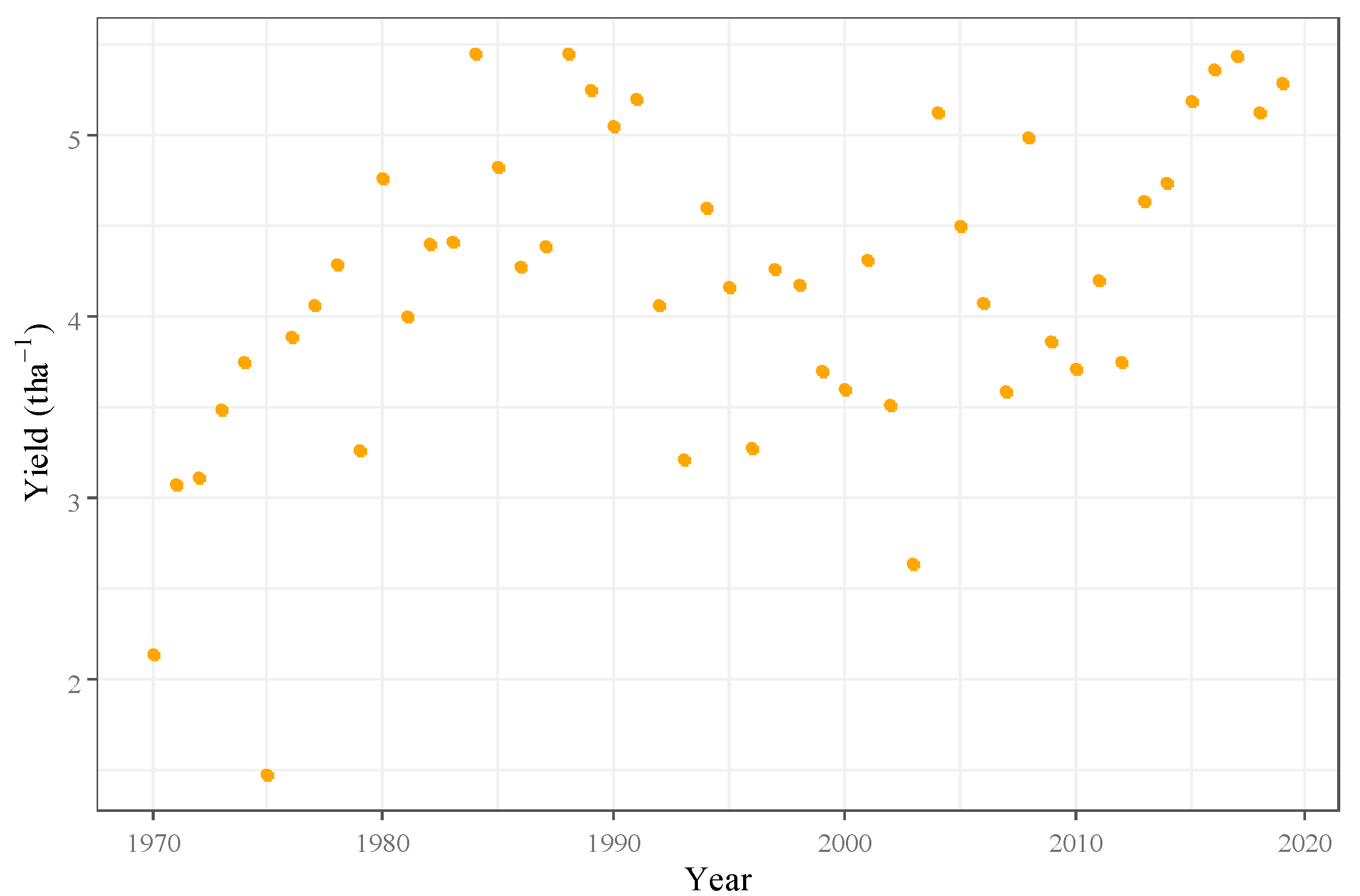

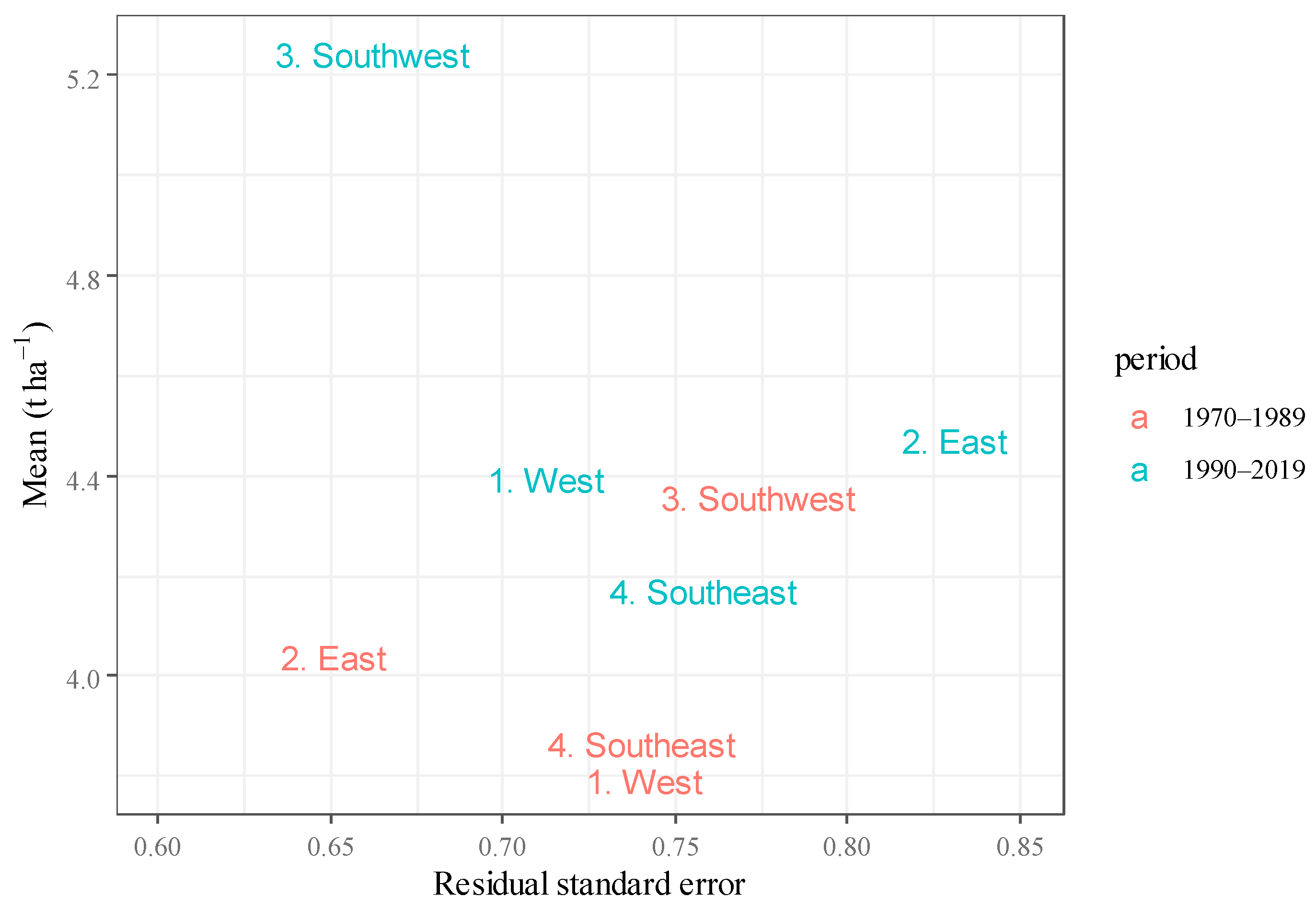
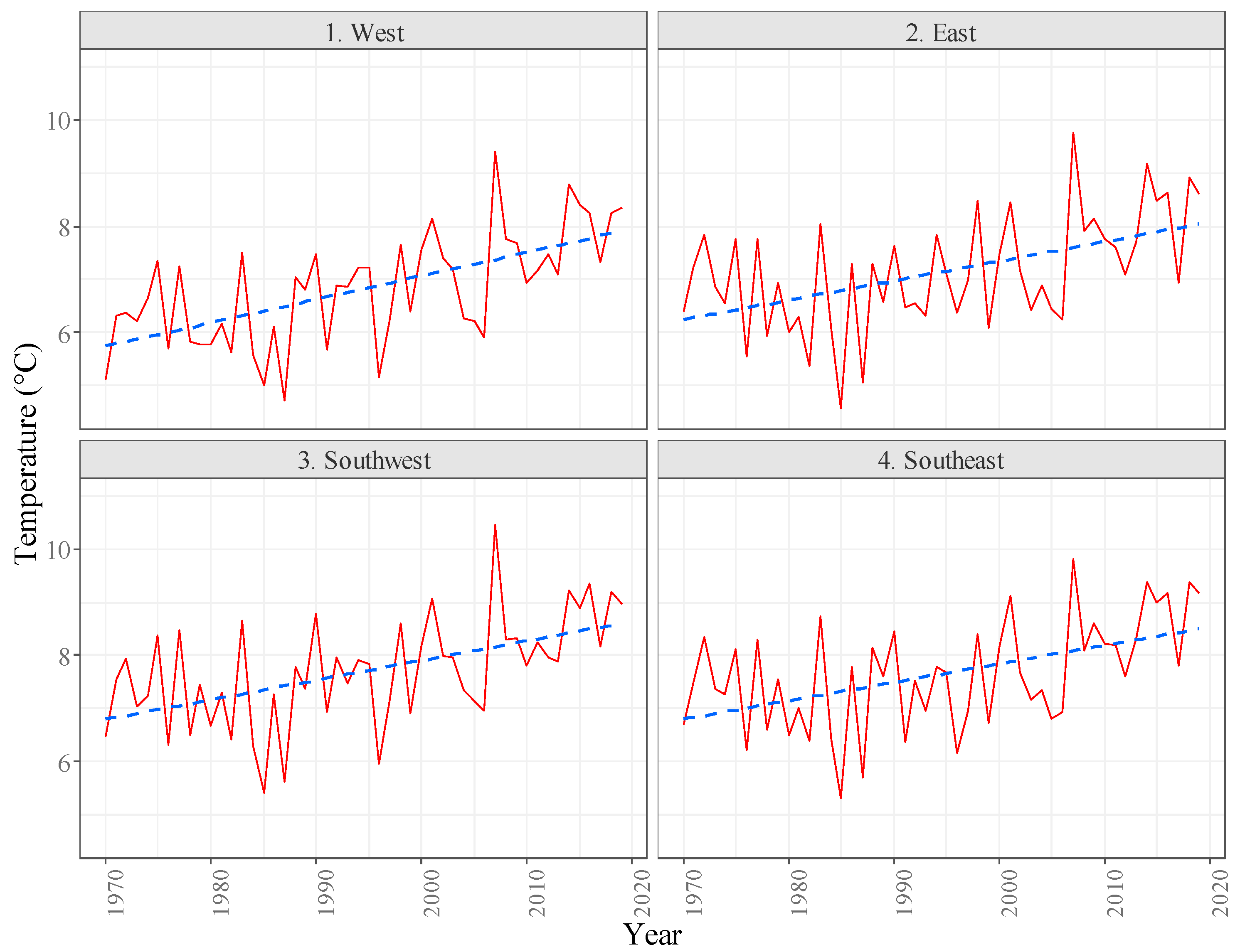
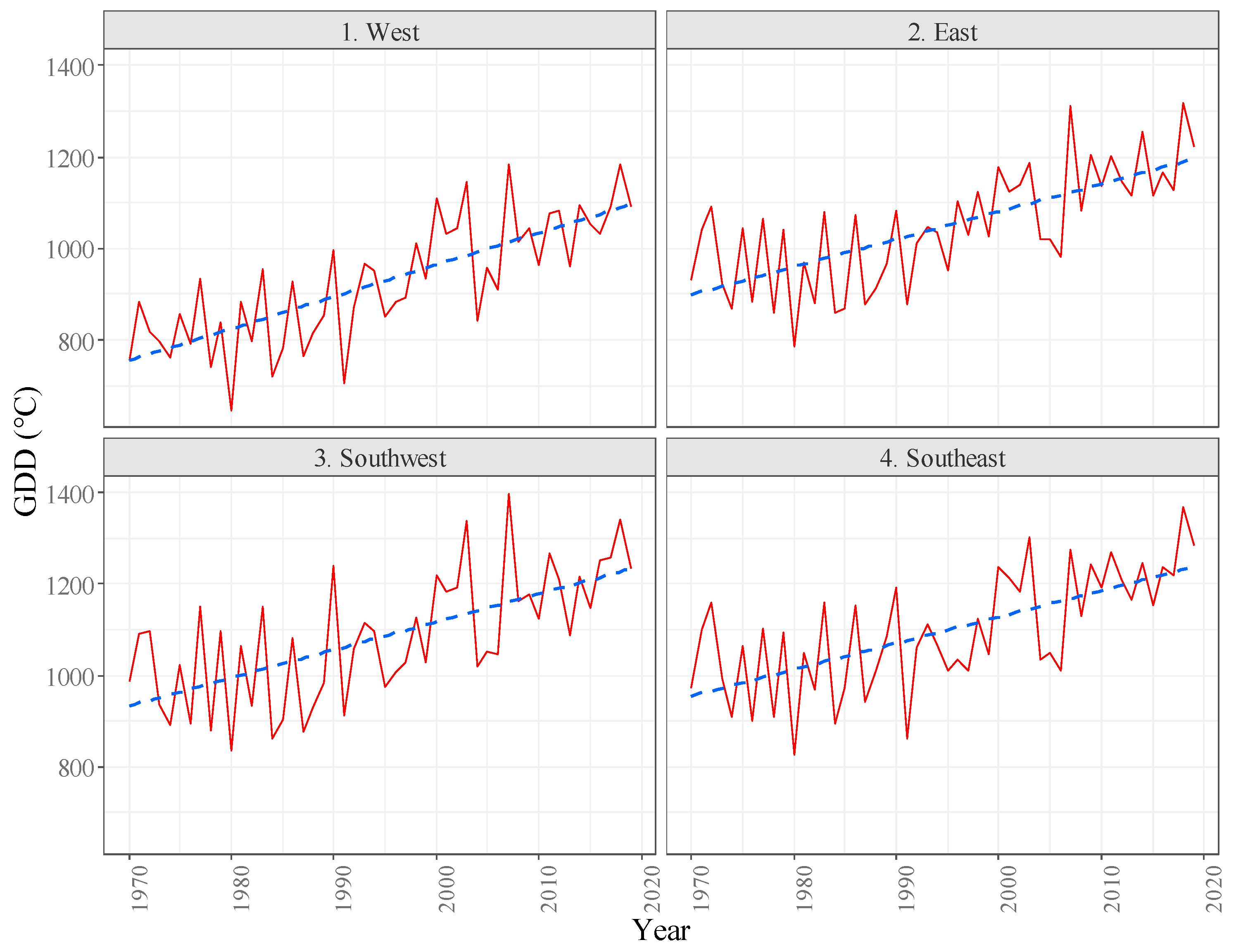

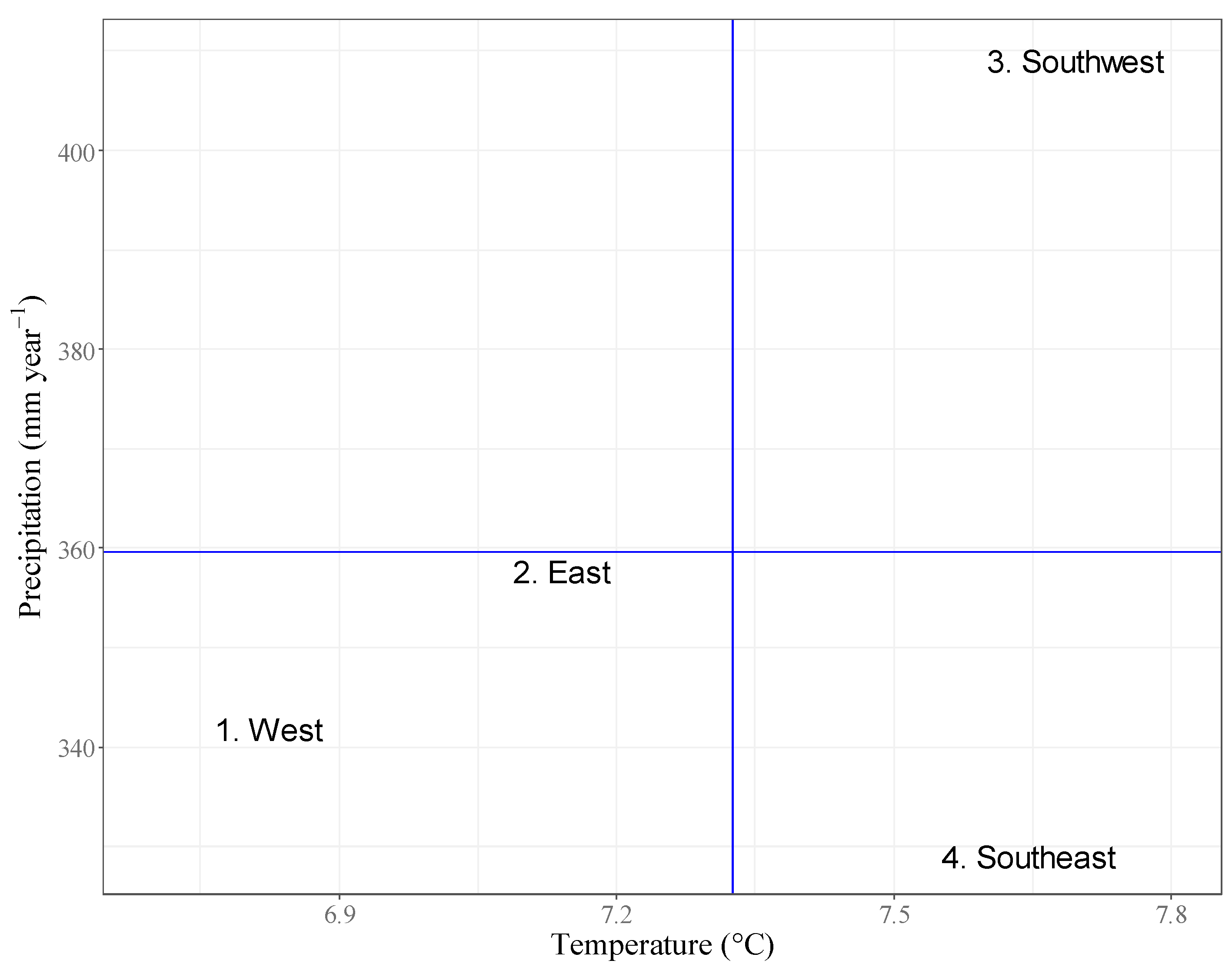

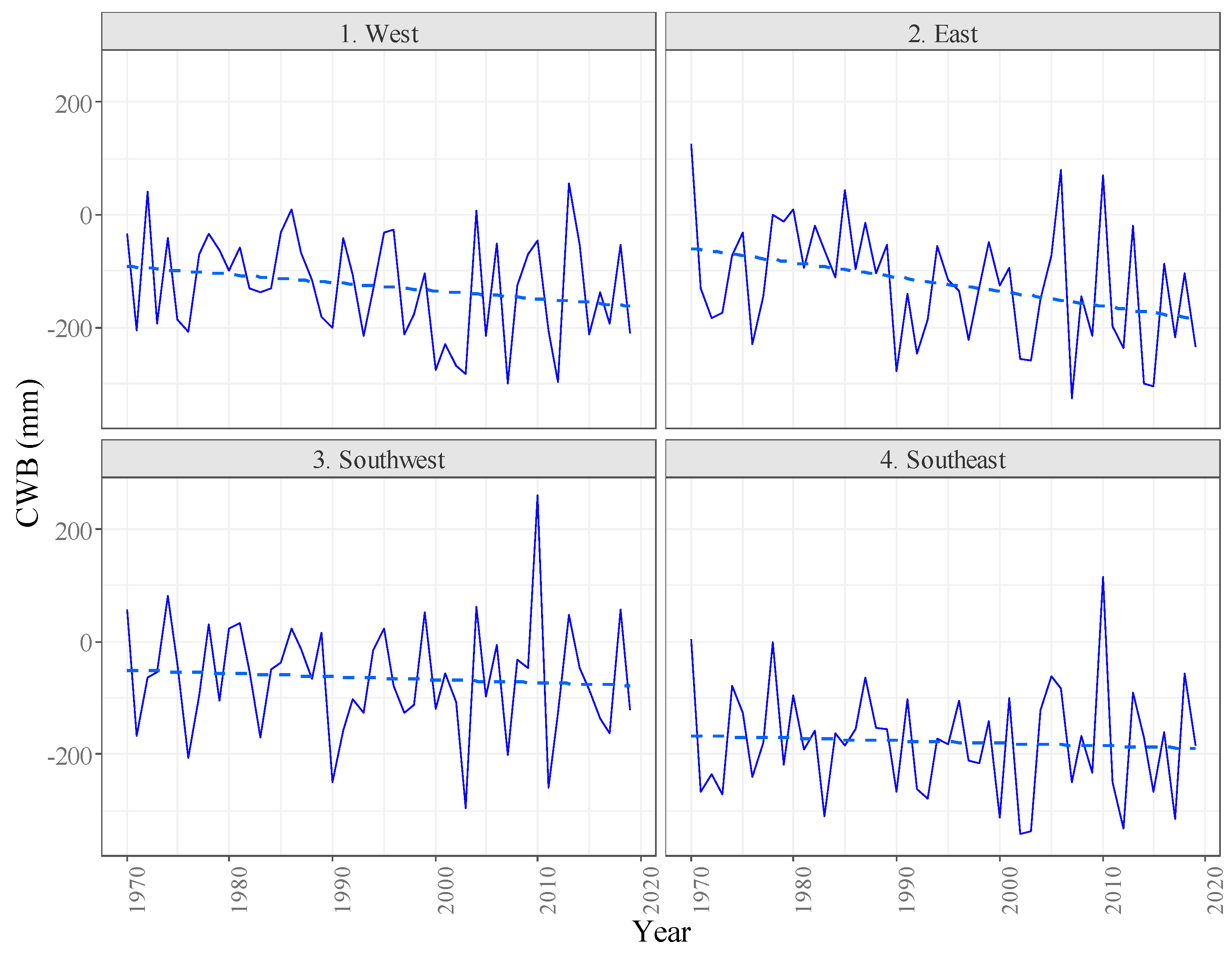
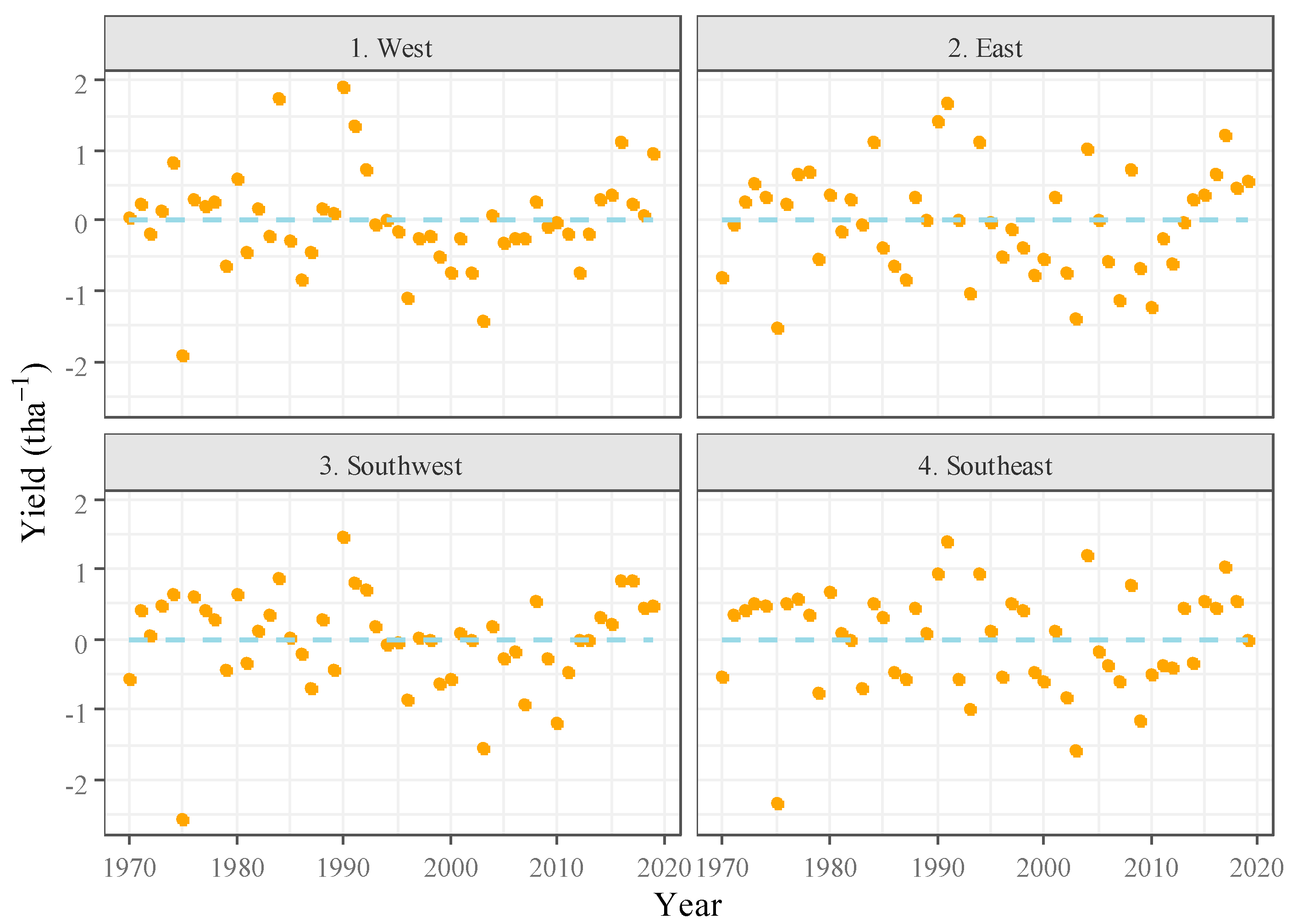
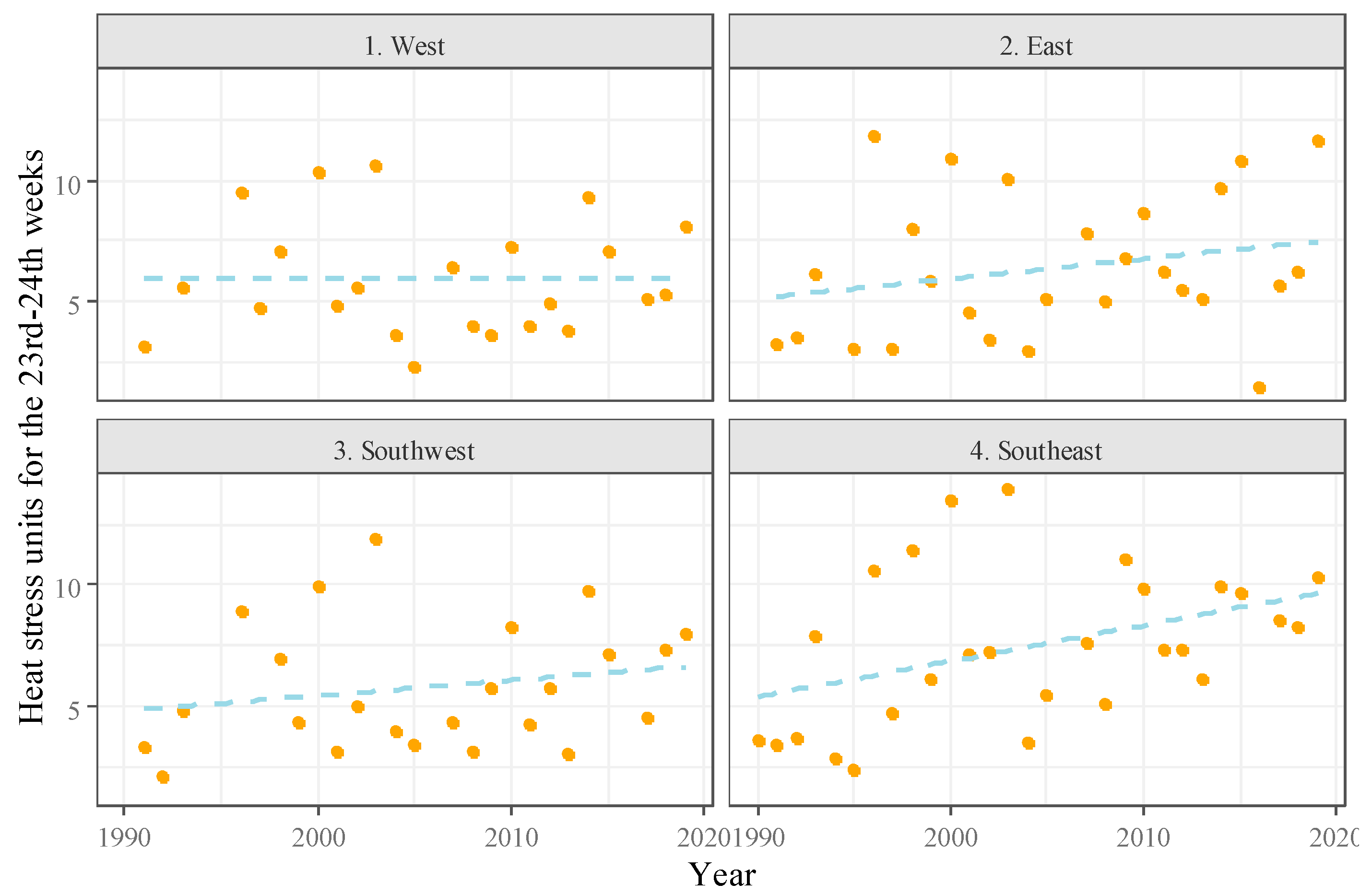
| Period | No. of Calendar Week | |
|---|---|---|
| stem elongation | 5 February–5 April | 5th–14th |
| heading | end of May, 4–9 days | 21st–22nd |
| anthesis | beginning of June, 4–6 days | 22nd |
| grain milk stage | 10–20 June, 10 days | 23rd–24th |
| grain dough stage | 20 June–1st July | 25th–26th |
| ripening | 1–20 July | 26th–29th |
| 1970–1989 | 1990–2019 | |||
|---|---|---|---|---|
| Region | W | p-Value | W | p-Value |
| 1. West | 0.974 | 0.827 | 0.977 | 0.728 |
| 2. East | 0.941 | 0.250 | 0.948 | 0.154 |
| 3. Southwest | 0.916 | 0.083 | 0.979 | 0.794 |
| 4. Southeast | 0.937 | 0.214 | 0.970 | 0.526 |
| Linear Trend Analysis (1970–1989) | |||
| Region | Estimate (t ha−1 year−1) | Residual Standard Error | R-Squared |
| 1. West | 0.127 | 0.741 | 0.519 |
| 2. East | 0.151 | 0.651 | 0.665 |
| 3. Southwest | 0.154 | 0.774 | 0.594 |
| 4. Southeast | 0.141 | 0.740 | 0.573 |
| Linear Trend Analysis (1990–2019) | |||
| Region | Estimate (t ha−1 year−1) | Residual Standard Error | R-Squared |
| 1. West | 0.050 | 0.712 | 0.285 |
| 2. East | n.s. | 0.831 | n.s. |
| 3. Southwest | 0.031 | 0.662 | 0.123 |
| 4. Southeast | n.s. | 0.758 | n.s. |
| Region | Week | r-Value | p-Value | b1 (t ha−1 °C−1) |
|---|---|---|---|---|
| 1. West | 19, 20, 23, 25 | −0.516 | 0.005 | −0.257 |
| 2. East | 21, 23 | −0.617 | 0.001 | −0.511 |
| 3. Southwest | 18, 19, 20, 23, 24 | −0.684 | 0.003 | −0.364 |
| 4. Southeast | 19, 21, 23, 24 | −0.612 | <0.001 | −0.161 |
| Region | Technological Development (t ha−1 year−1) | b1 (t ha−1 °C−1) | Heat Unit Increase (°C year−1) | Change by 2050 (t ha−1) |
|---|---|---|---|---|
| 1. West | 0.050 | −0.097 | n.s. | 1.55 |
| 2. East | n.s. | −0.110 | 0.08 | −0.27 |
| 3. Southwest | 0.031 | −0.129 | 0.06 | 0.72 |
| 4. Southeast | n.s. | −0.161 | 0.15 | −0.75 |
Publisher’s Note: MDPI stays neutral with regard to jurisdictional claims in published maps and institutional affiliations. |
© 2022 by the authors. Licensee MDPI, Basel, Switzerland. This article is an open access article distributed under the terms and conditions of the Creative Commons Attribution (CC BY) license (https://creativecommons.org/licenses/by/4.0/).
Share and Cite
Huzsvai, L.; Zsembeli, J.; Kovács, E.; Juhász, C. Response of Winter Wheat (Triticum aestivum L.) Yield to the Increasing Weather Fluctuations in a Continental Region of Four-Season Climate. Agronomy 2022, 12, 314. https://doi.org/10.3390/agronomy12020314
Huzsvai L, Zsembeli J, Kovács E, Juhász C. Response of Winter Wheat (Triticum aestivum L.) Yield to the Increasing Weather Fluctuations in a Continental Region of Four-Season Climate. Agronomy. 2022; 12(2):314. https://doi.org/10.3390/agronomy12020314
Chicago/Turabian StyleHuzsvai, László, József Zsembeli, Elza Kovács, and Csaba Juhász. 2022. "Response of Winter Wheat (Triticum aestivum L.) Yield to the Increasing Weather Fluctuations in a Continental Region of Four-Season Climate" Agronomy 12, no. 2: 314. https://doi.org/10.3390/agronomy12020314
APA StyleHuzsvai, L., Zsembeli, J., Kovács, E., & Juhász, C. (2022). Response of Winter Wheat (Triticum aestivum L.) Yield to the Increasing Weather Fluctuations in a Continental Region of Four-Season Climate. Agronomy, 12(2), 314. https://doi.org/10.3390/agronomy12020314








